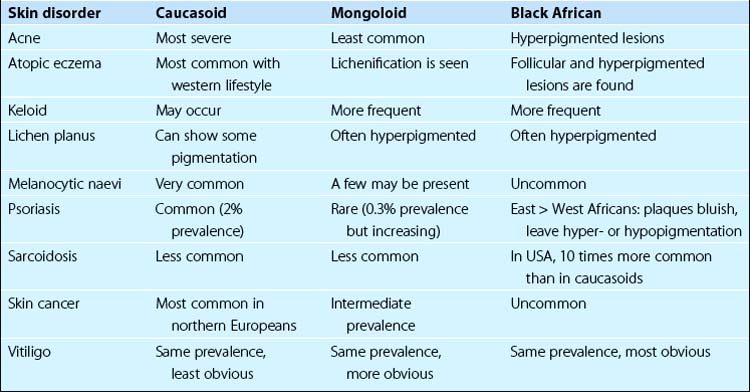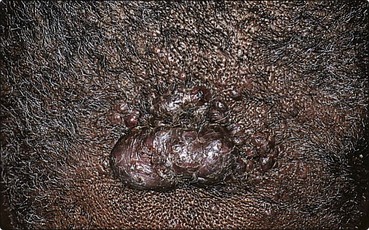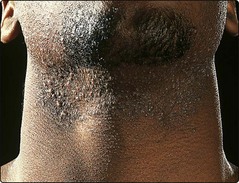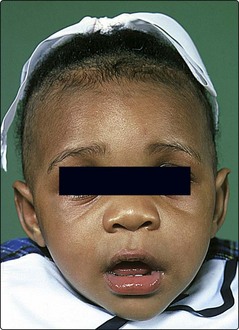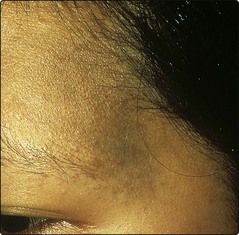Racially pigmented skin
Common dermatoses may show variable manifestations in different races due to differences in pigmentation, hair or the response of skin to external stimuli. In addition, some conditions have a distinct racial predisposition. The response of darkly pigmented skin to injury and to certain therapeutic modalities needs to be taken into account when planning a programme of management.
Racial differences in normal skin
The most obvious difference is in pigmentation (p. 74), but hair forms and colour also vary. Mongoloid hair is straight and has the largest diameter; black African hair is short, spiralled, drier and more brittle than that of other races; and caucasoid hair may be wavy, straight or helical. Hair colour is predominantly black in mongoloids and Africans, and black, blond or red in caucasoids. Body hair is most profuse in caucasoids. The black African stratum corneum differs from that of the caucasoid by showing greater intercellular adhesion and a higher lipid content.
Diseases that show racially dependent variations
In pigmented skin, eruptions that appear red or brown in white caucasoid skin may be black, grey or purple, and pigmentation can mask an erythematous reaction. Inflammation in pigmented skin often provokes a hyperpigmentary (Figs 1 and 2) or hypopigmentary (Table 1) reaction. Follicular, papular and annular patterns are more common in pigmented skin than in caucasoid. In addition, some skin disorders show an inter-racial variation in prevalence (Table 2).
| Division | Disorder |
|---|---|
| Infections | Leprosy, onchocerciasis, pinta, pityriasis versicolor |
| Papulosquamous disorders | Pityriasis rosea, pityriasis alba, psoriasis (occasionally), seborrhoeic dermatitis |
| Physical and chemical agents | Burns, cryotherapy, hydroquinone, topical potent steroids |
| Post-inflammatory | Discoid lupus erythematosus, systemic sclerosis, sarcoidosis |
| Other | Albinism, vitiligo |
Diseases with a distinct racial or ethnic predisposition
Hair disorders
Racially dependent hair conditions are most common in black Africans and include the following:
 Folliculitis keloidalis describes discrete follicular papules, often keloids, at the back of the neck in African males (Fig. 3). Intralesional steroids may help.
Folliculitis keloidalis describes discrete follicular papules, often keloids, at the back of the neck in African males (Fig. 3). Intralesional steroids may help.
 Pseudofolliculitis barbae is a common disorder in black African men and is characterized by inflammatory papules and pustules in the beard area. It is thought to result from hairs growing back into the skin (Fig. 4). Treatment is difficult but includes attention to shaving technique and the topical use of antibiotics and steroids.
Pseudofolliculitis barbae is a common disorder in black African men and is characterized by inflammatory papules and pustules in the beard area. It is thought to result from hairs growing back into the skin (Fig. 4). Treatment is difficult but includes attention to shaving technique and the topical use of antibiotics and steroids.
 Traction alopecia is mainly seen in black Africans because of the practice of plaiting or tightly braiding the hair (Fig. 5). Hairs are loosened from their follicles. The temples are often affected.
Traction alopecia is mainly seen in black Africans because of the practice of plaiting or tightly braiding the hair (Fig. 5). Hairs are loosened from their follicles. The temples are often affected.
 Hot-comb alopecia is a traction alopecia caused by applying a hot comb to oiled hair in order to straighten it (curly black African hair is usually straightened by chemical methods).
Hot-comb alopecia is a traction alopecia caused by applying a hot comb to oiled hair in order to straighten it (curly black African hair is usually straightened by chemical methods).
Pigmentary changes
 Dermatosis papulosa nigra describes small, seborrhoeic wart-like papules often seen on the face in black Africans.
Dermatosis papulosa nigra describes small, seborrhoeic wart-like papules often seen on the face in black Africans.
 Lines of hypo- or hyperpigmentation, often on the upper arms, are not infrequently found in black Africans.
Lines of hypo- or hyperpigmentation, often on the upper arms, are not infrequently found in black Africans.
 Longitudinal nail pigmentation and macular pigmentation of palms and soles occur mainly in black Africans.
Longitudinal nail pigmentation and macular pigmentation of palms and soles occur mainly in black Africans.
 Mongolian spot is a slate-brown pigmentation at the sacral area in a baby and is found in 100% of mongoloids, 70% or more of Africans and 10% of caucasoids. It usually fades by the age of 6 years.
Mongolian spot is a slate-brown pigmentation at the sacral area in a baby and is found in 100% of mongoloids, 70% or more of Africans and 10% of caucasoids. It usually fades by the age of 6 years.
 Naevus of Ota is a macular, slate-grey pigmentation in the upper trigeminal area, which may involve the sclera (Fig. 6). It is seen most frequently in mongoloids.
Naevus of Ota is a macular, slate-grey pigmentation in the upper trigeminal area, which may involve the sclera (Fig. 6). It is seen most frequently in mongoloids.
Other conditions
A racial preponderance is also seen with the following conditions:
 Sickle cell disease occurs in black Africans. The main cutaneous findings are painful oedema of the hands and feet, caused by infarction in the small bones, and leg ulceration.
Sickle cell disease occurs in black Africans. The main cutaneous findings are painful oedema of the hands and feet, caused by infarction in the small bones, and leg ulceration.
 Vascular naevi, such as the port wine stain naevus, and melanocytic naevi, are more common in caucasoids.
Vascular naevi, such as the port wine stain naevus, and melanocytic naevi, are more common in caucasoids.
Racially pigmented skin
 A race is a genetically defined group, although the characteristics of Homo sapiens are continuously variable.
A race is a genetically defined group, although the characteristics of Homo sapiens are continuously variable.
 The most numerous races are mongoloids, black Africans and caucasoids (the last include Middle East and Indian subcontinent peoples).
The most numerous races are mongoloids, black Africans and caucasoids (the last include Middle East and Indian subcontinent peoples).
 Eruptions that are red or brown in caucasoid skin may appear black, grey or purple in people with pigmented skin.
Eruptions that are red or brown in caucasoid skin may appear black, grey or purple in people with pigmented skin.
 Lichenification: inflammatory dermatoses tend to become lichenified in mongoloids and may be follicular in black Africans.
Lichenification: inflammatory dermatoses tend to become lichenified in mongoloids and may be follicular in black Africans.
 Hypopigmentation may follow from skin trauma, e.g. burns or from cryotherapy, topical steroids and some dermatoses, in pigmented skin.
Hypopigmentation may follow from skin trauma, e.g. burns or from cryotherapy, topical steroids and some dermatoses, in pigmented skin.
 Hair disorders, e.g. pseudofolliculitis, keloidal change or traction alopecia, are common in black Africans.
Hair disorders, e.g. pseudofolliculitis, keloidal change or traction alopecia, are common in black Africans.
 Pigmentary lines are frequently found on the limbs (e.g. the outer upper arm) or nails in black Africans and other races.
Pigmentary lines are frequently found on the limbs (e.g. the outer upper arm) or nails in black Africans and other races.
 Sacral mongolian spots are found in most mongoloid and black African babies, but in only a few caucasoid infants.
Sacral mongolian spots are found in most mongoloid and black African babies, but in only a few caucasoid infants.
 Vascular and melanocytic naevi (e.g. port wine stain) are more common in caucasoids than in other races.
Vascular and melanocytic naevi (e.g. port wine stain) are more common in caucasoids than in other races.








